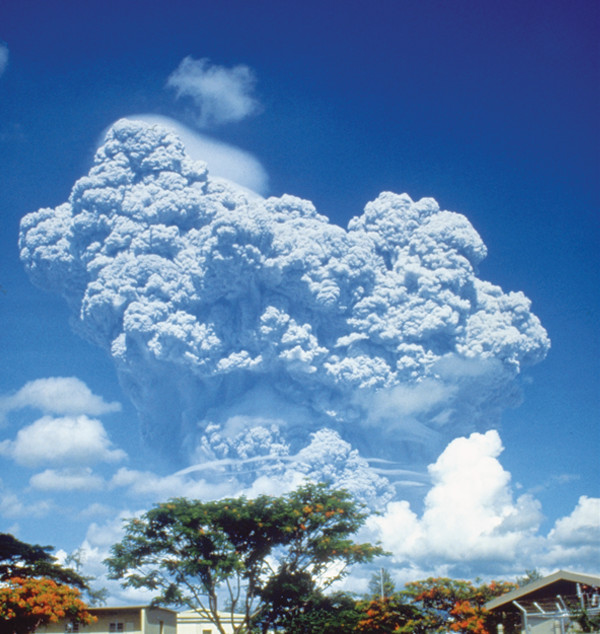
by Mary Caperton Morton Friday, October 31, 2014

Large volcanic eruptions, such as the 1991 eruption of Mount Pinatubo, can cool Earth, but geoengineering attempts to replicate the effects may lead to regional droughts. Credit: U.S. Geological Survey, photograph by Richard P. Hoblitt.
The realization that large volcanic eruptions can trigger climatic cooling has inspired some to call for stratospheric geoengineering projects, which mimic volcanic eruptions, to combat the effects of global warming. But the approach is not without risks. And a new study looking at the effects of volcanic eruptions on monsoon cycles in China over the past 700 years elucidates one: Eruptions can also cause profound drought in some regions. The finding suggests that although artificially induced cooling may have benefits in some places, it could backfire in others.
Particles in the atmosphere, such as sulfates ejected by explosive eruptions, reflect solar radiation, often leading to overall cooling trends. But the cooling effects tend to be stronger over land than over the ocean, reducing the temperature difference between the two. This temperature difference is what drives the development of summer monsoons, which deliver copious seasonal rainfall to many otherwise arid regions in Asia, Africa, Australia and the American Southwest, says Chaochao Gao, an environmental scientist at Zhejiang University in Hangzhou, China, and a co-author of the new study, published in the Journal of Geophysical Research – Atmospheres.
“Modeling studies have shown that artificial injection of sulfur into the stratosphere could lead to droughts, but we wanted to see if the risks were also apparent in a proxy dataset,” Gao says. Long-term proxies for precipitation can be hard to come by in many regions of the world, but northern China has a long history of droughts and famine, documented in detailed historical records.
By combining the written records with hydrologic tree ring data and overlapping the precipitation records with ice-core records documenting volcanic eruptions, Gao and colleagues identified several eruptions, followed by episodes of drought, for the time period between 1368 and 1911.
Climate cycles are notoriously difficult to model so it’s important to also conduct studies based on historical records, says Alan Robock, an atmospheric scientist at Rutgers University who was not involved in the new research. “Not many of these types of proxy-based studies have been done simply because there are few places in the world with long precipitation records,” he says.
Gao and colleagues found that large volcanic eruptions in the Northern Hemisphere often preceded strong droughts in China. The droughts typically began in the north in the second or third summer following an eruption and slowly moved southward over the next two to three years. The researchers also found that the severity of the drought depended on the size of the eruption and the amount of aerosol injected into the atmosphere, and that it took four to five years after an eruption for precipitation rates to recover. The drought pattern agrees with observations from three large modern eruptions, including that of Mount Pinatubo in the Philippines in 1991, Gao says.
The pattern represents a cautionary tale for geoengineering projects seeking to replicate the cooling effects of large volcanic eruptions, Robock says. “Historic volcanic eruptions show us that cooling effects in one place are often countered by negative effects elsewhere,” he says. “Geoengineering projects come with a long list of risks, and number one is the risk of regional droughts.”
© 2008-2021. All rights reserved. Any copying, redistribution or retransmission of any of the contents of this service without the expressed written permission of the American Geosciences Institute is expressly prohibited. Click here for all copyright requests.